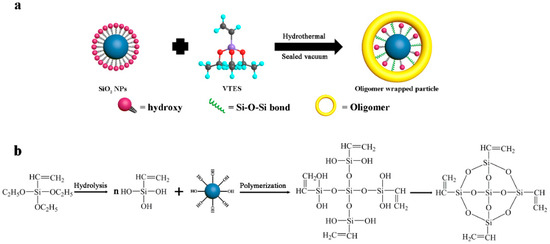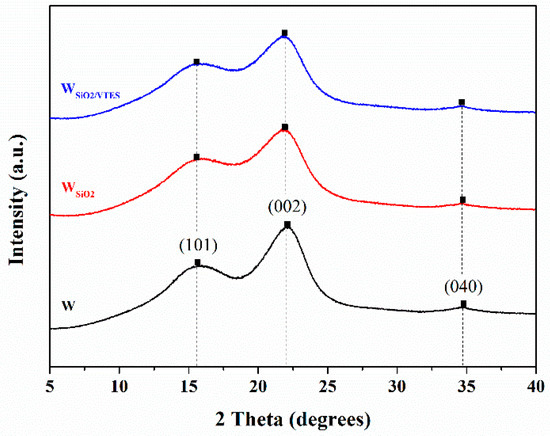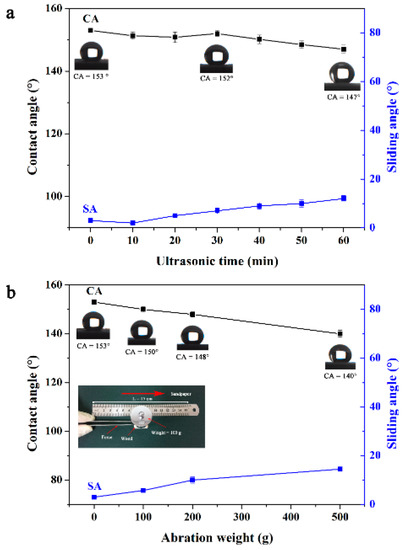Abstract
The poor durability and complex production process are two tough challenges for the practical application of superhydrophobic wood. In this work, high-mechanical-resistance superhydrophobic wood was fabricated by a one-step hydrothermal vacuum dipping method using SiO2 nanoparticles (SiO2 NPs) in combination with vinyltriethoxysilane (VTES). The as-prepared superhydrophobic surfaces exhibited water contact angles (CAs) greater than 152° and water sliding angles (SAs) less than 3°. It also exhibited robust stability and durability in harsh conditions, including finger wiping, water brushing, intense sandpaper abrasion, and severe ultrasonic cleaning. The superhydrophobic surface was created by the random distribution of oligomer-wrapped SiO2 NP spheres having different sizes. Further testing showed that the SiO2 NPs were firmly fixed on the wood substrate via chemical bonding, which contributed to the high wear resistance. The modification method developed in this work provides a simple and efficient route to fabricate large-scale, mechanically stable, and durable superhydrophobic surfaces for advanced engineering materials.
1. Introduction
Being renewable and environmentally friendly, having superior physical strength as well as being aesthetically pleasing, wood has been widely used in mankind′s daily lives in various applications, including construction, indoor decoration, furniture, and flooring [1]. One of the major disadvantages of untreated wood is hydrophilicity as a result of abundant hydroxyl groups in whole mass. Hygroscopic wood is vulnerable to attack by fungi and mildew, resulting in decay. By converting the hydrophilic hydroxyl groups into hydrophobic groups via chemical modification, the water resistance and dimensional stability of wood can be significantly improved. This will be beneficial to increase their durability and extend their service life [2,3,4].
The design of the superhydrophobic surface on wood is a promising method to solve the hygroscopicity problem [5]. To our knowledge, the superhydrophobic surface can be achieved by the following two approaches: (1) the creation of a suitable hierarchical roughness, and (2) the chemical modification of rough surfaces with low surface energy materials [6,7,8]. In order to create the suitable hierarchical roughness, methods such as sol-gel [9], layer-by-layer assembly [10,11], chemical vapor deposition [12], and electrochemical processes [13] have been reported. Low surface energy materials such as fluorosilane [14], plasma and organosilanes [15], and perfluorinated compounds [16] have been used to perform chemical modification. Although artificial superhydrophobic surfaces have been fabricated on various materials via the above-mentioned methods, the build processes are tedious and time-consuming. In addition, some of these methods are expensive and only applicable to small flat surfaces or specific homogeneous materials.
In this work, we investigate if SiO2 NPs modified by low surface energy vinyltriethoxysilane (VTES) can efficiently generate a superhydrophobic surface via a one-step hydrothermal vacuum dipping process. In detail, can SiO2 NPs be used to create hierarchical roughness and can VTES act as the adhesive for fixing SiO2 NPs on a wood surface? Finally, we study if the resulting superhydrophobic wood can display robust mechanical stability and durability in harsh conditions.
2. Materials and Methods
2.1. Materials
All the chemicals were supplied by Kebaiao Co., Beijing, China, and were used without further purification. Recently cut Populus euramericana (cv. ‘I-214′), which is one of the most common tree species in North China, was collected. The tree ages were about four to five years. Wood blocks with dimensions 20 mm longitudinal (L) × 20 mm tangential (T) × 20 mm radial (R) were obtained from the sapwood sections and dried at 60 °C for 24 h until mass constancy. The following abbreviations are used: natural wood (W), nano-SiO2-treated wood (WSiO2), and nano-SiO2/VTES-treated wood (WSiO2/VTES).
2.2. Preparation of Superhydrophobic Surfaces on Wood Substrate
Superhydrophobic surfaces using SiO2 NPs were fabricated on wood substrates as follows. (1) 100 mL of 30% (w/w) silica sol and 100 mL of 97% (w/w) VTES were added into 800 mL distilled water and stirred magnetically for 30 min, and then the resultant solution was subjected to an ultrasonic treatment for 1 h in a KQ-600DE computer numerical controlled (CNC) ultrasonic device (Kunshan Ultrasonic Instruments Co., Ltd., Kunshan, China) with an output power of 100 W. (2) The wood samples were placed in an engineered vacuum drier. The specimens were evacuated for 30 min (−0.1 MPa). (3) The obtained homogeneous mixture was transferred into the above vacuum drier and this vessel was persistently sealed and heated to 35 °C for 2.5 h. (4) Finally, the vessel was left to cool to room temperature. The prepared superhydrophobic wood were removed from the solution and dried at 80 °C until mass was constant. The morphology and microstructure were observed using a scanning electron microscope (SEM) (Hitachi SU-8020, Tokyo, Japan) operating at 3.0 kV. Fourier-transform infrared (FTIR) spectra were acquired by the KBr pellet technique (120-mesh particle size) using Bruker Tensor 27 (Bruker Optics, Ettlingen, Germany) with a 4 cm−1 resolution (32 scans were accumulated). For X-ray diffraction (XRD), the instrument XRD 6000 (Shimadzu, Kyoto, Japan) was used (graphite monochromatic with Cu Kα radiation). The patterns were obtained between 5° and 40° 2θ with 0.05° steps and a scan speed of 2°∙min−1. Water contact angles (CAs) and sliding angles (SAs) were measured using a 5 μL distilled water droplet by a CA analyzer (JC2000D, Powereach, Shanghai, China) at room temperature.
3. Results and Discussion
3.1. The Investigation of Formation Mechanism
Superhydrophobic surfaces were successfully fabricated via a one-step hydrothermal vacuum dipping method proposed in this paper. The functionalization process was performed by the interaction of hydroxyl groups on the surface of the SiO2 NPs with ethyoxyl from VTES. The sizes of the SiO2 particles of WSiO2 and the superhydrophobic particles of WSiO2/VTES obtained were observed under SEM images. Figure 1a shows that the stacks of SiO2 NPs as well as the shape (sphere) and size (100 nm) of a single SiO2 can be seen clearly. Figure 1b shows that the average size of superhydrophobic particles was 10 μm. With supporting evidence from the FE-SEM images, it can be concluded that the particle size increased to the micro level from the nanoscale level. This probably attributed to a high degree of oligomer formation on the SiO2 NPs’ surface [17].

Figure 1.
FE-SEM images of (a) SiO2 NPs stacks of WSiO2 and (b) superhydrophobic particles of WSiO2/VTES surfaces; (c) FTIR spectra of WSiO2/VTES.
Figure 1c displays the FTIR spectra of WSiO2/VTES at ambient temperature from 4000 to 400 cm−1. The peaks at 3422 cm−1 and 1602 cm−1 can be assigned to –OH stretching and bending vibrations, respectively, which are mainly chemical bonds interacting within the SiO2 NPs and hydrophilic wood substrate and enabling the fabrication of rough surfaces [18,19]. The clear decrease in the intensity of these two peaks was observed due to the formation of ether linkages between SiO2 NPs and wood substrates. The peak at 788 cm−1 can be assigned to Si–O stretching, arising from the SiO2 particle [20]. The peaks at 1647 cm−1 and 750 cm−1 were due to C=C and Si–C vibrations, respectively [21]. The origin of C=C and Si–C groups was attributed to the presence of VTES. The band at 2903 cm−1 is a C–H stretching vibration and alkyl groups like –CH2 were mainly responsible for the superhydrophobicity [22]. The peak at 1050 cm−1 can be assigned to Si–O–Si asymmetric stretching vibrations [23]. –O–C2H5 groups were replaced with Si–OH groups due to the hydrolysis of VTES. So, there were an amount of –OH groups on hydrolyzed VTES surfaces and they can react with each other to form Si–O–Si bonds immediately. The Si–O–Si bond with –OH groups can further react to form short oligomer chains. The reaction between VTES and SiO2 particles occurred via –OH groups on their surface. As a result, VTES and SiO2 particles were chemically bonded through the Si–O–Si bonds. The probable reactions resulting in the oligomer formation on the SiO2 surface are shown in Figure 2.

Figure 2.
(a) Synthesis of oligomer-wrapped SiO2 NPs using VTES at 35 °C under vacuum conditions and (b) the chemical reaction route occurring during the formation of oligomer-wrapped SiO2 NPs.
3.2. X-ray Powder Diffraction (XRD) Analysis
Figure 3 shows the XRD patterns of the W, WSiO2, and WSiO2/VTES. As shown in Figure 3, similar diffraction peaks at 15.6° 2θ (101), 22.0° 2θ (002), and 34.6° 2θ (040) appear in the W, WSiO2, and WSiO2/VTES, which originated from the crystalline region of the cellulose in the wood [24]. According to the results of experimentation, SiO2 NPs and SiO2 NP/VTES treatment do not change the crystalline structures within the cell wall. The crystallinity of the W was 26.5%, while the result for the WSiO2/VTES was 20.2%. The diffraction peak intensity and the relative crystallinity decreased in WSiO2/VTES due to the amorphous SiO2/VTES present in the composite.

Figure 3.
XRD patterns of (a) W, (b) WSiO2, and (c) WSiO2/VTES.
3.3. Mechanical Durability of the Superhydrophobic Wood Surfaces
The superhydrophobic performance of WSiO2/VTES after ultrasonic washing (40 KHz, 100 W) for 60 min was investigated. Figure 4a shows the change in CAs and SAs as an influence of ultrasonic washing time for the WSiO2/VTES. It can be observed that the CAs of the surface remained almost constant around 151°, and SAs exhibited only a slight increase, up to 12°, after ultrasonic washing for a duration of 60 min. This indicated that the SiO2/VTES complex coating was ultrasonic resistant, and the outgoing adhesive properties of the hybrid coating was therefore durable enough to withstand the ultrasonic impact without destroying its water resistance.

Figure 4.
(a) CAs and SAs as a function of time of ultrasonic washing in water for the superhydrophobic wood surfaces; (b) The effect of sandpaper (standard sandpaper, grit no. 300) abrasion on the CAs and SAs at 0–500 g at 150 mm abrasion length. The inset is a schematic illustration of the sandpaper abrasion test.
In order to further investigate the mechanical stability of the robust superhydrophobic WSiO2/VTES, a sandpaper (1500 mesh) abrasion test was carried out. As shown in Figure 4b, the superhydrophobic surface of WSiO2/VTES was placed on sandpaper, and then different weights (0 g, 100 g, 200 g, and 500 g) were applied to the top of WSiO2/VTES. Finally, the WSiO2/VTES burdened with different weights was horizontally pushed for 15 cm along the ruler. It was apparent that the wood surface maintained its superhydrophobic performance in the range from 0 g to 200 g but lost its superhydrophobicity when the weight increased to 500 g (the CAs value was 140° and SAs value was 14°). The sandpaper abrasion test indicated that the as-prepared superhydrophobic wood surface had some limitations for uploading weights and overloading impaired the superhydrophobic wood surface. However, the damaged superhydrophobic wood surfaces still had a strong water resistance.
4. Conclusions
In summary, a durable and mechanically robust superhydrophobic surface using SiO2 NPs combined with VTES modification was successfully fabricated through a facile, one-step hydrothermal vacuum dipping method. The superhydrophobic surface exhibited exceptional water repellency, having high CAs larger than 152° and low SAs less than 3°. And this high water-resistance performance was attributed to hierarchical roughness (stacks of SiO2 NPs) and low surface energy material (VTES). The superhydrophobic surface on the wood substrate was durable enough to withstand long ultrasonic washing while retaining its superhydrophobicity. In addition, the superhydrophobic surface possessed good mechanical resistance to sandpaper abrasion. Such a durable and mechanically robust superhydrophobic wood surface could widely expand the range of possible applications of wood-based materials.
Author Contributions
X.H. and J.P. conceived and designed the experiments. X.H., Z.W. and Q.Z. carried out experiments and analyzed the data. All authors contributed to the writing and reviewing of the manuscript.
Funding
Special Fund for Beijing Common Construction Project and Beijing Forestry University, Grant No. 2016HXKFCLXY001.
Acknowledgments
This work was funded by Special Fund for Beijing Common Construction Project and Beijing Forestry University, Grant No. 2016HXKFCLXY001.
Conflicts of Interest
The authors declare no conflict of interest.
References
- Sandberg, D.; Kutnar, A.; Mantanis, G. Forestry Wood modification technologies-a review. iForest-Biogeosci. For. 2017, 10, 895. [Google Scholar] [CrossRef]
- Chang, H.; Tu, K.; Wang, X.; Liu, J. Fabrication of mechanically durable superhydrophobic wood surfaces using polydimethylsiloxane and silica nanoparticles. RSC Adv. 2015, 5, 30647–30653. [Google Scholar] [CrossRef]
- Fu, Y.; Li, G.; Yu, H.; Liu, Y. Hydrophobic modification of wood via surface-initiated ARGET ATRP of MMA. Appl. Surf. Sci. 2012, 258, 2529–2533. [Google Scholar] [CrossRef]
- Latthe, S.S.; Sutar, R.S.; Kodag, V.S.; Bhosale, A.; Kumar, A.M.; Sadasivuni, K.K.; Xing, R.; Liu, S. Self-cleaning superhydrophobic coatings: Potential industrial applications. Prog. Org. Coat. 2019, 128, 52–58. [Google Scholar] [CrossRef]
- Papadopoulos, A.N.; Mantanis, G.I.; Technology, P. Surface treatment technologies applied to wood surfaces. FDM Asia-Solid Wood Panel Technol. 2011, 7, 36–39. [Google Scholar]
- Feng, L.; Li, S.; Li, H.; Zhai, J.; Song, Y.; Jiang, L.; Zhu, D. Super-hydrophobic surface of aligned polyacrylonitrile nanofibers. Angew. Chem. Int. Ed. 2002, 41, 1221–1223. [Google Scholar] [CrossRef]
- Lee, C.; Kim, C.-J. Underwater restoration and retention of gases on superhydrophobic surfaces for drag reduction. Phys. Rev. Lett. 2011, 106, 014502. [Google Scholar] [CrossRef]
- Wang, S.; Liu, C.; Liu, G.; Zhang, M.; Li, J.; Wang, C. Fabrication of superhydrophobic wood surface by a sol-gel process. Appl. Surf. Sci. 2011, 258, 806–810. [Google Scholar] [CrossRef]
- Yang, M.; Liu, W.; Jiang, C.; He, S.; Xie, Y.; Wang, Z. Fabrication of superhydrophobic cotton fabric with fluorinated TiO2 sol by a green and one-step sol-gel process. Carbohydr. Polym. 2018, 197, 75–82. [Google Scholar] [CrossRef]
- Lin, D.; Zeng, X.; Li, H.; Lai, X. Facile fabrication of superhydrophobic and flame-retardant coatings on cotton fabrics via layer-by-layer assembly. Cellulose 2018, 25, 3135–3149. [Google Scholar] [CrossRef]
- Wang, S.; Shi, J.; Liu, C.; Xie, C.; Wang, C. Fabrication of a superhydrophobic surface on a wood substrate. Appl. Surf. Sci. 2011, 257, 9362–9365. [Google Scholar] [CrossRef]
- Aljumaily, M.M.; Alsaadi, M.A.; Das, R.; Hamid, S.B.A.; Hashim, N.A.; AlOmar, M.K.; Alayan, H.M.; Novikov, M.; Alsalhy, Q.F.; Hashim, N.A. Optimization of the synthesis of superhydrophobic carbon nanomaterials by chemical vapor deposition. Sci. Rep. 2018, 8, 2778. [Google Scholar] [CrossRef]
- Ren, Y.; Lin, Z.; Mao, X.; Tian, W.; Van Voorhis, T.; Hatton, T.A. Superhydrophobic, Surfactant-doped, Conducting Polymers for Electrochemically Reversible Adsorption of Organic Contaminants. Adv. Funct. Mater. 2018, 28, 1801466. [Google Scholar] [CrossRef]
- Zhu, Q.; Teng, F.; Wang, Z.; Wang, Y.; Lu, N. Superhydrophobic Glass Substrates Coated with Fluorosilane-Coated Silica Nanoparticles and Silver Nanoparticles for Surface-Assisted Laser Desorption/Ionization Mass Spectrometry. ACS Appl. Nano Mater. 2019, 2, 3813–3818. [Google Scholar] [CrossRef]
- Novák, I.; Valentin, M.; Špitalský, Z.; Popelka, A.; Sestak, J.; Krupa, I. Engineering Superhydrophobic polyester/cotton fabrics modified by barrier discharge plasma and organosilanes. Polym. Plast. Technol. Eng. 2018, 57, 440–448. [Google Scholar] [CrossRef]
- Kim, S.; Thirion, D.; Nguyen, T.S.; Kim, B.; Dogan, N.A.; Yavuz, C.T. Sustainable synthesis of superhydrophobic perfluorinated nanoporous networks for small molecule separation. Chem. Mater. 2019, 31, 5206–5213. [Google Scholar] [CrossRef]
- Santhosh, K.K.S.; Sukamanchi, R.; Mathew, D.; Nair, C.P.R. Long-living, Stress and pH Tolerant Superhydrophobic Silica Particles via Fast and Efficient Urethane Chemistry; Facile Preparation of Self-Recoverable SH Coatings. J. Mater. Chem. A 2014, 3, 1465–1475. [Google Scholar]
- Barata, M.A.B.; Neves, M.C.; Neto, C.P.; Trindade, T. Growth of BiVO4 particles in cellulosic fibres by in situ reaction. Dye. Pigment. 2005, 65, 125–127. [Google Scholar] [CrossRef]
- Hübert, T.; Unger, B.; Bücker, M. Sol & ndash; gel derived TiO2 wood composites. J. Sol-Gel Sci. Technol. 2010, 53, 384–389. [Google Scholar]
- Han, X.; Yin, Y.; Zhang, Q.; Li, R.; Pu, J. Improved wood properties via two-step grafting with itaconic acid (IA) and nano-SiO2. Holzforschung 2018, 72, 499–506. [Google Scholar] [CrossRef]
- Fan, Y.; Li, C.; Chen, Z.; Hong, C. Study on fabrication of the superhydrophobic sol-gel films based on copper wafer and its anti-corrosive properties. Appl. Surf. Sci. 2012, 258, 6531–6536. [Google Scholar] [CrossRef]
- Mahadik, S.A.; Pedraza, F.; Vhatkar, R.S. Silica based superhydrophobic coating for long-term industrial and domestic applications. J. Alloys Compd. 2016, 663, 487–493. [Google Scholar] [CrossRef]
- Chen, H.; Lang, Q.; Bi, Z.; Miao, X.; Li, Y.; Pu, J. Impregnation of poplar wood (Populus euramericana) with methylolurea and sodium silicate sol and induction of in-situ gel polymerization by heating. Holzforschung 2014, 68, 45–52. [Google Scholar] [CrossRef]
- Islam, M.S.; Hamdan, S.; Jusoh, I.; Rahman, M.R.; Ahmed, A.S. The effect of alkali pretreatment on mechanical and morphological properties of tropical wood polymer composites. Mater. Des. 2012, 33, 419–424. [Google Scholar] [CrossRef]
© 2019 by the authors. Licensee MDPI, Basel, Switzerland. This article is an open access article distributed under the terms and conditions of the Creative Commons Attribution (CC BY) license (http://creativecommons.org/licenses/by/4.0/).